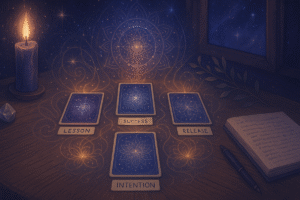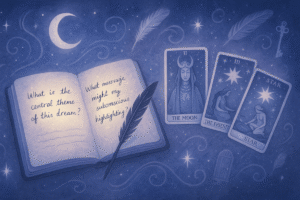Table of Contents
Starting a tarot journal might feel overwhelming at first. I remember staring at a blank notebook for weeks before writing my first entry. The truth is, there’s no perfect way to begin, and that’s actually the beauty of it. Your tarot journal becomes a deeply personal space where you can explore thoughts, patterns, and insights that emerge during your readings.
Perhaps you’ve been drawn to tarot for a while but haven’t found a way to make the practice stick. Or maybe you’re already reading cards but feel like the insights slip away too quickly. A tarot journal bridges that gap, creating a lasting record of your inner dialogue with the cards.
Why Keep a Tarot Journal
The act of writing transforms fleeting impressions into concrete observations. When you document your tarot experiences, you’re not just recording what happened during a reading. You’re creating a conversation with yourself across time.
I’ve noticed that patterns become visible only when you can look back at entries from weeks or months ago. That recurring Three of Cups might represent your need for community. The Page of Wands showing up during stressful periods could signal your desire for creative expression as an outlet.
Your journal also becomes a safe space to question your initial interpretations. Sometimes what feels like a negative card in the moment reveals itself as guidance toward necessary change when viewed with hindsight. This process of reflection deepens your relationship with both the cards and your own intuitive responses.
Setting Up Your Tarot Journal Space
Choose a journal that feels right to you, though don’t overthink this decision. Some people prefer lined notebooks for structure, while others gravitate toward blank pages that offer complete creative freedom. I started with a simple composition notebook and later moved to something with heavier paper that wouldn’t bleed through when I used different pens.
Consider keeping your journal near your tarot deck. This physical proximity makes it easier to maintain a consistent practice. You might also want to include a favorite pen or set of colored pencils if you enjoy adding visual elements to your entries.
The key is removing barriers that might prevent you from writing. If you have to search for supplies every time you want to journal, you’re less likely to maintain the habit. Think of your setup as creating a small ritual space that supports regular reflection.
Getting Started With Your First Entries
Your first journal entry doesn’t need to be profound or perfectly written. Start with the basics about your reading, but don’t stop there. What drew you to pull cards today? What was happening in your life? How did you feel before you began?
Record which cards appeared, but focus more on your personal response to them than on textbook meanings. Did the imagery remind you of something specific? What emotions surfaced when you saw certain cards? These immediate reactions often contain valuable insights that standard interpretations might miss.
I think many people get stuck because they feel they need to “get it right” in their journal. But the journal is for exploration, not perfection. Let yourself write messy, incomplete thoughts. Circle back to add more when ideas develop.
Ten Powerful Prompts for Self-Discovery
These prompts can guide your journaling practice and help you dig deeper into what your tarot readings might be reflecting back to you.
What Part of This Reading Surprised Me
Surprise often indicates that we’ve touched on something our conscious mind wasn’t expecting. Write about which card or combination caught you off guard. What assumptions might this challenge? Sometimes the cards that make us uncomfortable are pointing toward areas where growth is possible.
How Do These Cards Mirror My Current Life Situation
Look for connections between the card imagery and your actual circumstances. Perhaps the Two of Pentacles reflects your struggle to balance work and personal time. Maybe the Hermit appeared when you’ve been feeling isolated. These parallels can reveal patterns in how you navigate challenges.
What Would I Tell a Friend If These Were Their Cards
This prompt creates helpful distance from your own situation. When we advise others, we often access wisdom that feels blocked when applied to ourselves. Write what you might say to someone else who drew these cards, then consider how that advice might apply to your own circumstances.
What Am I Avoiding Looking At
This can be a challenging prompt, but it’s often the most revealing. Sometimes cards appear that make us squirm because they’re highlighting something we’d rather not examine. Use your journal as a safe space to explore what you might be resisting or denying.
What Strengths Do These Cards Highlight
Focus on the positive qualities or resources the cards might be reflecting. Even traditionally challenging cards like The Tower or Five of Pentacles can point toward resilience, the ability to start fresh, or the wisdom that comes from difficult experiences.
How Have Similar Themes Appeared in Previous Readings
This prompt requires looking back through earlier journal entries, which is why keeping records becomes so valuable. Recurring themes often indicate important life lessons or persistent patterns that deserve attention. Track these themes over time to see how they evolve.
What Action Might These Cards Be Suggesting
Frame this carefully to avoid prescriptive thinking. Instead of “The cards say I should quit my job,” try “What if this reading is inviting me to consider how I feel about my current work situation?” This approach maintains your personal agency while opening space for reflection.
What Question Would I Ask These Cards If I Could
Sometimes the cards seem to be answering questions we didn’t know we were asking. Write about what deeper question might be lurking beneath the surface. This can help you understand what’s really on your mind, even when you can’t articulate it directly.
How Do I Feel Different After This Reading
Pay attention to shifts in your emotional or mental state. Do you feel more hopeful? More confused? More determined? These changes can be just as meaningful as the specific cards that appeared. Sometimes a reading’s value lies in how it changes your perspective rather than in any particular message.
What Would I Like to Explore Further
End your journal entries by identifying threads you’d like to follow in future readings or reflection. This creates continuity in your practice and helps you develop deeper ongoing dialogues with recurring themes in your life.
Building Your Journaling Practice
Consistency matters more than length when developing a journaling habit. I’ve found that writing even a few sentences after each reading creates momentum that longer, sporadic entries cannot match.
Set realistic expectations for yourself. If daily journaling feels overwhelming, commit to writing after weekend readings. If you only read cards once a week, that’s perfectly fine. The goal is creating a sustainable practice that serves your growth over time.
Don’t worry about your writing quality or whether your insights seem profound enough. Your journal is for you, not for anyone else to judge. Some entries will feel more meaningful than others, and that’s completely normal.
Making Your Journal Work for You
Your journaling practice should evolve as you do. Maybe you start by focusing on individual card meanings but later become more interested in card combinations. Perhaps you begin with simple three-card spreads but eventually want to track more complex layouts.
I’ve noticed that my journaling style has changed significantly over the years. Early entries were very focused on trying to decode what the cards meant. Now I write more about what questions the cards raise and how they make me think differently about situations I’m facing.
Some people enjoy adding sketches or color-coding different types of insights. Others prefer pure text. There’s no right or wrong approach, only what feels authentic and helpful to you.
Remember that your tarot journal is ultimately about developing a deeper relationship with yourself. The cards become tools for self-reflection, and your journal becomes the space where that reflection transforms into understanding. Through this practice, you create a record of your inner growth and wisdom that becomes more valuable over time.
Frequently Asked Questions
Do I need to look up card meanings or trust my intuition first?
Both approaches have value, though many experienced practitioners suggest looking at the card imagery before consulting any guidebook. Write down what you notice first about the symbols, colors, and emotions the card evokes. Then look up the traditional meaning and see how it connects with your initial impression. This dual approach helps you develop your intuitive voice while still learning the established interpretations.
How often should I write in my tarot journal?
There’s no magic frequency that works for everyone. Some people pull a card and journal every morning as part of their routine. Others write only when they do larger readings or when they feel called to reflect. What matters most is finding a rhythm you can actually maintain. Starting with once or twice a week often feels more sustainable than forcing daily entries that become a chore.
What if I look back and my interpretations were completely wrong?
This is actually one of the most valuable aspects of keeping a journal. When you revisit old entries and see where your interpretation didn’t match what actually unfolded, you’re learning how to read the cards more accurately. Sometimes what felt wrong was actually pointing toward something you weren’t ready to see yet. Either way, these “misses” teach you more about both tarot and yourself than getting everything right ever could.
Should I keep my tarot journal private or share it?
Your journal is primarily for you, so privacy often allows for more honest reflection. However, some people find that sharing select entries with trusted friends or online communities helps them process insights more deeply. You might keep most of your journal private while occasionally sharing specific readings that you’d like other perspectives on. The choice depends entirely on what serves your growth best.







